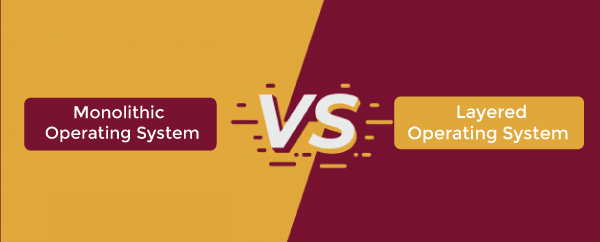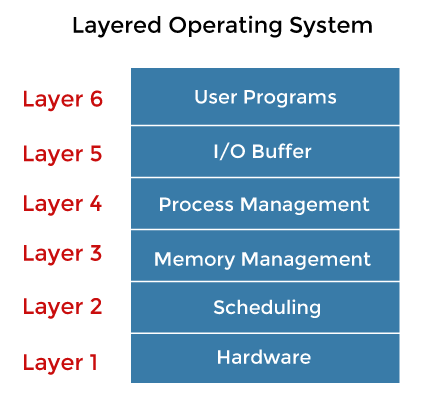Difference between Monolithic and layered Operating SystemIn this article, you will learn the difference between monolithic and layered operating systems. But before discussing this, you must know about monolithic and layered operating systems with their advantages and disadvantages. 
What is the Monolithic Operating System?It is a very simple operating system in which file management, device management, process management, and memory management are all controlled directly from the kernel. All of these components, including file management and memory management, are located within the kernel. It is also known as the monolithic kernel. It is an old type of operating system. They were used in banks to do small tasks such as batch processing and time-sharing. The monolithic kernel serves as a virtual machine that manages all hardware components. It is not the same as a microkernel, which has limited tasks. There are two parts to a microkernel: kernel space and userspace. Both of these components communicate with others via IPC (Inter-process communication). The benefit of using a microkernel is that if one server fails, the other takes control. Monolithic architecture operating systems were first used in the 1970s. Monolithic operating systems have three major layers: the application layer, the monolithic kernel, and the hardware layer. Every application in these operating systems has its own address space. As a result, the applications are safer. The kernel manages the operating system services, including the file system, memory manager, and CPU scheduler. Advantages and disadvantages of Monolithic operating systemThere are various advantages and disadvantages of a monolithic operating system. Some of them are as follows: Advantages
Disadvantages
What is a Layered Operating System?An operating system with different layers for handling system software and user software is known as a layered operating system. The lower layers are the responsibility of core system software, while the above layers are responsible for handling application software. A layered operating system that has divided into multiple layers, and each layer serves as a certain task. The goal of developing layered operating systems is to get around monolithic operating systems' limitations. It was created to improve existing structures such as UNIX's Monolithic and Simple structures (MS-DOS). 
There are mainly six layers in the layered operating system. These layers are as follows: 1. Hardware The OS architecture's the lowest layer, and it is where the hardware devices are handled. 2. CPU Scheduling It manages the scheduling tasks and schedules the processes for the CPU. 3. Memory Management It manages the memory. It moves processes from disk to the primary memory for execution and returns the executed programs to disk. 4. Process Management It handles the processes, and it also assigns the CPU to execute processes. 5. Input-Output Buffer It allows the users to interface with the system and controls IO device buffers, and ensure that IO devices work properly. 5. User Programs It is associated with the user programs like word processors, browsers, etc. All the programs are handled in this layer. Advantages and disadvantages of layered operating systemThere are various advantages and disadvantages of a layered operating system. Some of the advantages and disadvantages are as follows: Advantages 1. Easy Debugging It is very simple to debug because the layers are discrete. If an error happens in the CPU scheduling layer, the developer may only debug that layer. 2. Modularity This design supports modularity because each layer only executes tasks it is scheduled to perform. 3. Abstraction Each layer is concerned with its own set of functions. As a result, the functions and implementations of the other layer are abstract to it. 4. Easy update A modification in one layer does not affect the other layers. Disadvantages 1. Complex and better implementation Layer layout is important because a layer can utilize the services of the layers below it. For example, the backup storage layer uses the memory management layer's services, so it must be stored beneath the memory management layer. 2. Slower in execution When one layer wishes to interact with another, it sends a request that must traverse all layers between the two layers to be fulfilled. It enhances response time, which is faster than the Monolithic system. As a result, increasing the number of layers may lead to a very inefficient design. Main differences between the monolithic and layered operating systemHere, you will learn the main differences between the monolithic and the layered operating system. There are various main differences between the monolithic and the layered operating system. Some of the differences are as follows:
Head-to-head comparison between the monolithic and layered operating systemHere, you will learn the head-to-head comparison between the monolithic and the layered operating system. There are various comparisons between the monolithic and the layered operating system. Some of them are as follows:
ConclusionThere are two types of operating systems: monolithic and layered. The monolithic operating systems run in kernel space. In contrast, a layered operating system that has divided into multiple layers, and each of these layers serve as a specific task.
Next TopicMutex vs Semaphore
|
 For Videos Join Our Youtube Channel: Join Now
For Videos Join Our Youtube Channel: Join Now
Feedback
- Send your Feedback to [email protected]
Help Others, Please Share









